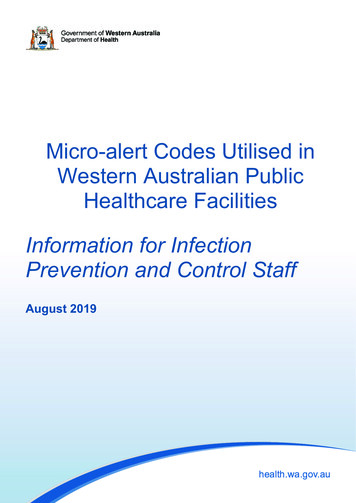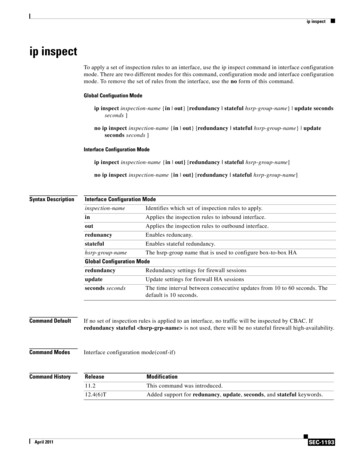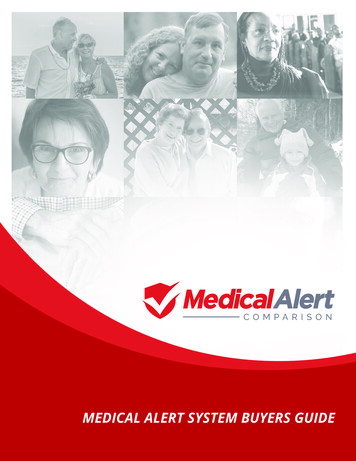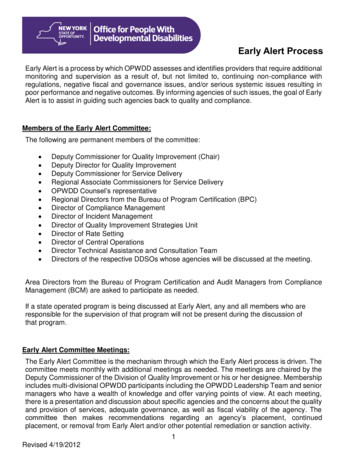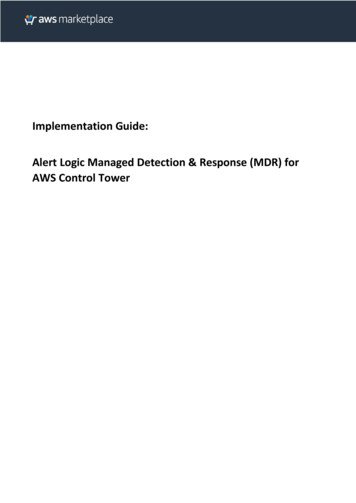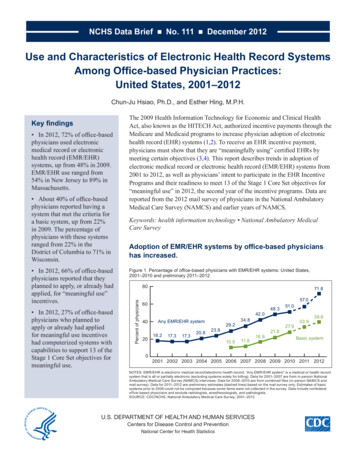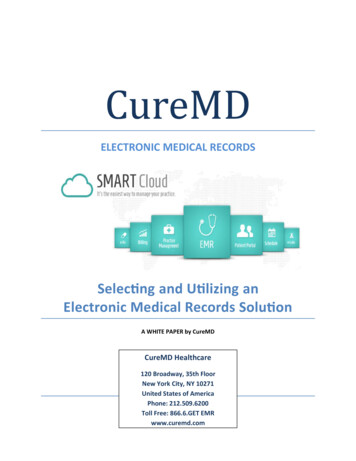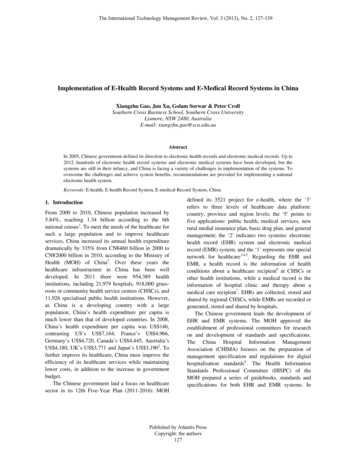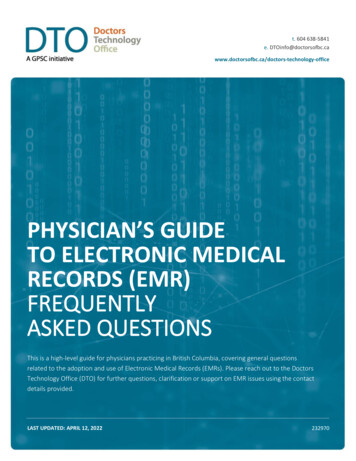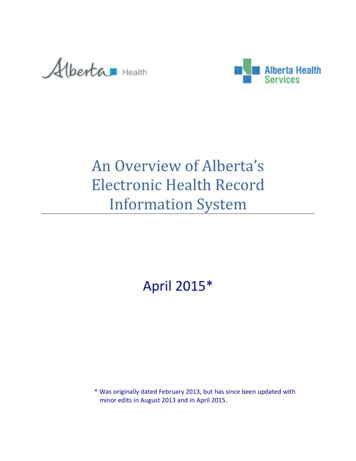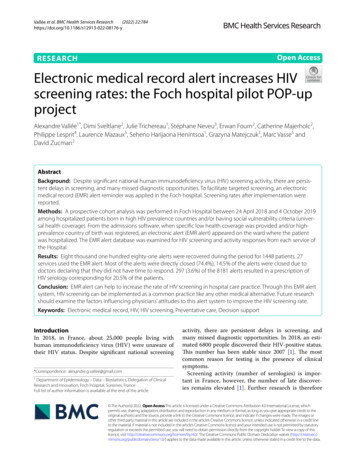
Transcription
(2022) 22:784Vallée et al. BMC Health Services Open AccessRESEARCHElectronic medical record alert increases HIVscreening rates: the Foch hospital pilot POP‑upprojectAlexandre Vallée1*, Dimi Sveltlane2, Julie Trichereau1, Stéphane Neveu3, Erwan Fourn2, Catherine Majerholc2,Philippe Lesprit4, Laurence Mazaux5, Seheno Harijaona Henintsoa1, Grazyna Matejczuk3, Marc Vasse5 andDavid Zucman2AbstractBackground: Despite significant national human immunodeficiency virus (HIV) screening activity, there are persistent delays in screening, and many missed diagnostic opportunities. To facilitate targeted screening, an electronicmedical record (EMR) alert reminder was applied in the Foch hospital. Screening rates after implementation werereported.Methods: A prospective cohort analysis was performed in Foch Hospital between 24 April 2018 and 4 October 2019among hospitalized patients born in high HIV prevalence countries and/or having social vulnerability criteria (universal health coverage). From the admissions software, when specific low health coverage was provided and/or highprevalence country of birth was registered, an electronic alert (EMR alert) appeared on the ward where the patientwas hospitalized. The EMR alert database was examined for HIV screening and activity responses from each service ofthe Hospital.Results: Eight thousand one hundred eighty-one alerts were recovered during the period for 1448 patients. 27services used the EMR alert. Most of the alerts were directly closed (74.4%), 14.5% of the alerts were closed due todoctors declaring that they did not have time to respond. 297 (3.6%) of the 8181 alerts resulted in a prescription ofHIV serology corresponding for 20.5% of the patients.Conclusion: EMR alert can help to increase the rate of HIV screening in hospital care practice. Through this EMR alertsystem, HIV screening can be implemented as a common practice like any other medical alternative. Future researchshould examine the factors influencing physicians’ attitudes to this alert system to improve the HIV screening rate.Keywords: Electronic medical record, HIV, HIV screening, Preventative care, Decision supportIntroductionIn 2018, in France, about 25,000 people living withhuman immunodeficiency virus (HIV) were unaware oftheir HIV status. Despite significant national screening*Correspondence: alexandre.g.vallee@gmail.com1Department of Epidemiology – Data – Biostatistics, Delegation of ClinicalResearch and Innovation, Foch Hospital, Suresnes, FranceFull list of author information is available at the end of the articleactivity, there are persistent delays in screening, andmany missed diagnostic opportunities. In 2018, an estimated 6800 people discovered their HIV-positive status.This number has been stable since 2007 [1]. The mostcommon reason for testing is the presence of clinicalsymptoms.Screening activity (number of serologies) is important in France, however, the number of late discoveries remains elevated [1]. Further research is therefore The Author(s) 2022. Open Access This article is licensed under a Creative Commons Attribution 4.0 International License, whichpermits use, sharing, adaptation, distribution and reproduction in any medium or format, as long as you give appropriate credit to theoriginal author(s) and the source, provide a link to the Creative Commons licence, and indicate if changes were made. The images orother third party material in this article are included in the article’s Creative Commons licence, unless indicated otherwise in a credit lineto the material. If material is not included in the article’s Creative Commons licence and your intended use is not permitted by statutoryregulation or exceeds the permitted use, you will need to obtain permission directly from the copyright holder. To view a copy of thislicence, visit http:// creat iveco mmons. org/ licen ses/ by/4. 0/. The Creative Commons Public Domain Dedication waiver (http:// creat iveco mmons. org/ publi cdoma in/ zero/1. 0/) applies to the data made available in this article, unless otherwise stated in a credit line to the data.
Vallée et al. BMC Health Services Research(2022) 22:784needed to improve targeting techniques for peopleliving with HIV who are unaware of their HIV status.There are several barriers to HIV screening, such asthinking not to be at risk of acquiring HIV and not discussing risk-taking issues with the physician. For healthprofessionals, the difficulty of speaking about HIV,avoidance of the subject of HIV, but also lack of training both to propose and do the test [2]. Similar studiesin Europe and The United States have confirmed thisfinding [3–5].Significant challenges remain in implementing published guidelines [6]. In France, it is recommended thatat least one HIV test be offered to the general population, when using care and more frequently for at-riskpopulations.There is no organized HIV screening strategy duringhospitalization. HIV screening during hospitalization israrely carried out except in certain services (maternity,internal medicine, and haemodialysis) while migrantsand people living in precarious situations can be hospitalized in all departments of the hospital. On the otherhand, patients often believe that they have had a routineHIV test done during their hospitalization whatever thepathology leading to hospital admission.Moreover, the initial HIV serology prescription wasvery heterogeneous in our hospital. Before the implementation of this study, HIV screening was very poor insurgical departments of our hospital, which had led toseveral deaths, in particular cases of cerebral toxoplasmosis mistaken for cerebral metastases due to the lackof knwoledge of HIV infection in hospitalized patients.On the other hand, many services had a significant oreven systematic use of screening tests (e.g. haemodialysis, maternity) representing a high number of tests. Inparallel, the use of prescription alerts was implementedseveral years ago for multiresistant bacteria to antibiotics and emerging bacteria highly resistant to antibioticscreening and practices for isolating and carrier patients.As a result, there are many missed opportunities forHIV screening in a hospital. Physicians and hospitalsare increasingly being evaluated based on their adherence to screening recommendations. Electronic medical report alerts (EMR alert) have become a commonlyused method to encourage physicians to use screening. Although many physicians have expressed concernabout “alert fatigue,” the literature suggests that EMRimproves screening rates for many conditions, includingbreast cancer, osteoporosis, abdominal aortic aneurysms,hepatitis C and obesity [7–11]. Despite the latest studies showing positive effects for HIV screening [12], EMRalert for HIV screening data remain uncertain. Indeed,several studies have shown an increase in HIV screeningwith EMR alert in association with other interventionsPage 2 of 8[13–15], while other studies show on the contrary noeffect of these EMR alerts [16].Thus, the objective of our study was to assess theimpact of the EMR alert reminder on rates of screeningfor HIV in a hospital care practice.MethodFoch hospital is a non-profit medical-surgical hospitallocated in France, access to which is open to the entirepopulation of the area. Of the 44,000 annual hospitalizations, approximately 2000 vulnerable/precarioushospitalized patients (having state medical aid (AME) /universal health coverage (CMU) or complementary universal health coverage (CMUc)) have been identified. HIVscreening activity has proven to be non-existent ( 100tests/year) in the various surgical departments (thoracic,visceral, urology, neurosurgery, etc.) even though thesedepartments receive as many disadvantaged patients asthe medical departments. Throughout the hospital, about2200 HIV serology tests are carried out per year (mandatory screenings carried out by the maternity department have been excluded). There are only 200 serologytests prescribed by the Emergency Department per yearfor more than 40,000 emergency visits. This situation isprobably not specific to Foch hospital. Faced with theseextremely low screening figures, it became necessary toset up a “POP-Up” electronic alert within the Foch hospital to raise the awareness of medical personnel andimprove screening practices. This innovative researchwas a first in France.Thus, a prospective cohort analysis, non-randomizedand monocentric study was performed for all patientshospitalized in Foch Hospital between 24 April 2018 and04 October 2019. The study was approved by the FochIRB: 2016-A01194–47.The major benefit of this research is to try to improveHIV screening practices among vulnerable and disadvantaged hospitalized patients at Foch Hospital.The main objective of this study was to investigate thepractice of hospital doctors in Foch hospital following theimplementation of an EMR alert to encourage targetedscreening for HIV infection according to specific sociodemographic criteria.Patients were included if aged over 18 years, had AME,CMU or CMUc or were born in high HIV prevalencecountries such as: sub-Saharan Africa, the West Indies,South America, Asia, Eastern Europe [17, 18]. In France,migrants, largely from sub-Saharan Africa, represent asignificant proportion of HIV cases (38% in 2015). Thispopulation is mainly covered by AME/CMU. They represent 40% of undiagnosed HIV-infected individuals [19].Exclusion criteria were people with engaged vital prognostic (unable to consent due to alteration of conscience)
Vallée et al. BMC Health Services Research(2022) 22:784at the time of hospitalization, those not having given consent, and people already knowing their HIV status.For patients: age, gender, health coverage, country ofbirth were recovered.EMR alert characteristicsTo avoid the “fatigue reminder” effect [20] the windowwill not be blocking, ticking an item does not generateanother window. Only one window will appear with allthe necessary information. This simplicity proved effective in the study of Federman et al. [21].From the “AXYA” admissions software, as soon asthe type of AME or CMU health coverage are providedand/or the high-prevalence country of birth were registered, an electronic alert (a bridge between the admission software and the medical prescription software“OMNIPRO”) appears on the ward where the patient ishospitalized (computerized medical record).The Computer Science Department of Foch hospitalwill extract using this software:For the patient: Anonymized socio-demographic data of hospitalizedpatients: initials (1st letter of surname and 1st letterof first name), age, gender, country of birth, type ofhealth cover (AME or CMU), serology performed(date and results). The name of the prescribing doctor and the service, The name of the hospitalization service.For the doctor: The name of the service, The opening date of the POP-UP, The answers to the POP-UP questions described inparagraph 3.2.1.1.Retrospective data for the last 12 months of patientshospitalized at Foch Hospital (no identification ofpatients will be extracted): number of hospitalizations,number of serologies performed, number of patientswith socio-demographic criteria justifying HIV screening(medical coverage and country of birth).In the POP-Up window physicians see:1 - The current summary of recommendations for HIVscreening.2- Six checkboxes: Prescription of HIV serology (with brief note). No time to respond to the alert. Patient who has already had a serology dating fromless than 3 months Patient followed for HIV infection.Page 3 of 8 Patient who refused the test. Clinical condition of the patient not allowing toobtain his non-opposition.This alert can only close if it is informed. If the alertwas directly closed or the “no time to respond to thealert” was clicked, the alert was repeated every day during the patient hospitalization stay.Statistical analysisCharacteristics of the study population were described asabsolute numerical values and proportions for categorical variables.ResultsIn total, 8181 alerts were recovered during the periodfor 1448 patients. 27 hospitalization units used the EMRalert. Most of the alerts were directly closed (74.4%),14.5% of the alerts were closed due to clinicians declaring that they had no time to respond. 297 (3.6%) of the8181 alerts resulted in a prescription of HIV serology butcorresponding to 20.5% of the patients (Table 1). For 523patients (36.1%) the EMR alert was unique since 23.9% ofthe alerts resulted in prescribed HIV serology (Table 1).For the remaining 925 when the EMR alert was repeatedthe median (25th to 75th percentile) of alerts was 6 [3-10] and resulted in 18.6% of patients who were prescribed an HIV serology (Table 1).Among the 1448 patients, 51.9% were male, 86.6% wereCMU and 69.7% of them came from Africa. The meanage of patients was 55.9 [18–91] years (Table 2).The first four services prescribing HIV serology withthe EMR alert were nephrology (18.2% of total), neurology (16.2% of total), internal medicine (14.1% of total)and digestive surgery (10.4% of total) (Table 3). On the297 HIV serologies, 182 gave a result (61.3% [57.7–68.9]of the total). 98.9% of the serologies were negative, while2 were positive (1.1% [0.2–4.3]. One of the positive HIVtests was found in Cardiology, and the other in the Nephrology department, the triggering factor being social vulnerability for one and high prevalence country of birthfor the other. One of the two patients admitted havingalready had an HIV positive test done. The newly discovered patient was linked to care during his hospitalization. Nephrology (40.6%), digestive surgery (40.3%) andneurology (34.5) remained the first services with a higherHIV serology prescription rate based on the number ofhospitalizations (Table 3).DiscussionThe purpose of this study was to assess the impact of theEMR alert on targeted HIV screening rates in hospitalcare practice. The results of the study showed that the
Vallée et al. BMC Health Services Research(2022) 22:784Page 4 of 8Table 1 Distribution of medical responses to POP-UP alertsOverall responses (1.448patients, 8.181 alerts)Responses for MD of patientsLast response for MD ofwith only one hospitalization (523 patients with multiplepatients)hospitalizations (925patients)n%n%n%0-Window directly closed608774.411822.5651355.461-Prescription of HIV serology2973.6312523.917218.592-No time to respond to the alert118814.52295.54818.763-Patient who has already had a serology less 307than 3 months old3.7519637.4811011.894-Patient followed for HIV infection650.79499.37151.625-Patient who refused the test290.3550.96242.596-Clinical condition of the patient not allowing to obtain his non-opposition2082.5410.19101.08Table 2 Characteristics of the study population of 1.0Health coverageAMECMU54386.6SS152.4Missing data824Alert originBirth country83657.7Social security48433.4Both1288.8Geographic regionSouth America151.56Asia13213.69Africa67269.71Eastern Europe countries656.74Guyane80.83Haiti727.47Age of patientsn% 30 years735.07]30–40 years]19213.33]40–50 years]24416.94]50–60 years]30521.18]60–70 years]39227.2223416.26 70 yearsstate medical aid (AME)universal health coverage (CMU)SS: social securityEMR alert led to a prescription of HIV serology in 20.5%of the targeted population. Previous studies have shownthat EMR was associated with a reduction in the numberof patients who have never been screened for HIV [12–14]. Similarly, an Indian study showed that the introduction of an electronic recall for 1 year was associated withhigher rates of HIV screening [15]. However, it appearedthat these encouraging results would only be effective inthe event of systematic recalls [16].Overall, our results are complements to a growingnumber of findings supporting the use of an EMR alert,even for traditionally stigmatizing conditions such asHIV infection. However, only 61% of the prescribedserologies were carried out. The prescription was unfortunately only rarely followed up in service teams, onepossible explanation could be patient refusal or lack oftime by healthcare teams for non-priority care faced withthe urgency of support.EMR alert is easily usable by health professionals andconsists of a simple prescription reminder to help healthprofessionals to better screen precarious populations inthe face of the national and international public healthchallenge that is HIV screening. Even if only one test waspositive, the large number of tests carried out may showthe need for such devices to allow better management ofpatients at risk. In the United-States, the use of this toolhas been strongly encouraged by health authorities toavoid variability in practices but also medical errors inthe management of HIV or other pathologies [22–24].The introduction of the EMR alert is mainly accompanied by improved practices and often reduced costs[25]. EMR is not intended to replace the clinician’s judgment, but rather to provide a tool that helps health careteams manage effectively. Indeed, this tool allows themto have the latest recommendations of the experts and
Vallée et al. BMC Health Services Research(2022) 22:784Page 5 of 8Table 3 Number of POP-UP alerts among number of hospitalizations for each service of the HospitalServicePOP-UP alertshospitalizationsHIV serologyprescriptions% HIV 394834.532Thoracic 534841011.94Internal etric4257522.70Urgency28930723.34Digestive 1252500.00Vascular y surgery101000.00Others2319210.50thus permits better clinical decisions. EMRs have provedeffective in improving the care of people living with HIV.This improves HIV screening and that for other sexuallytransmitted infections [26–30]. An American team fromOhio [31] implemented an EMR system from the computerized patient record from July to December 2009.After its implementation there were four times as manyHIV serologies prescribed. This alert was a reminderof HIV screening recommendations and sent an HIVscreening order. This same experiment was done by aNew York team, the implementation of the EMR alloweda marked increase in the number of serologies: 5.4% versus 8.7% [32].Automatic recall would be particularly effective inincreasing screening rates in patients with low baselinescreening rates. Older adults have been identified as apopulation that has not met its screening goals. HIVscreening among people aged 50–64 years increasedslightly after recommended universal screening in 2006,and then decreased again over time to a prevalence ofonly 3.7% in 2010 [33].A recent study showed that EMR significantlyimproved the use of screening, particularly in patientsaged 46 to 65 years [12]. Low screening rates in olderadults may reflect the beliefs of practitioners in a lowepidemiological risk of HIV in middle-aged and olderpopulations [34]. Although, this discrepancy supportsthe need for universal HIV screening that was recommended in 2009 in France [35], this strategy has not beenimplemented. Targeted screening appears more feasibleand acceptable by health care professionals. However, thedirect refusal of patients and the risk of stigmatizationdespite the goodwill of practitioners cannot be excludedand this fear remains a barrier for opt-in strategies.The frequency of patients’ hospitalizations was notassociated with the likelihood of receiving an HIVscreening, with or without the EMR [12]. While it may bethought that more frequent visits would result in higherrates of HIV screening through numerous EMR alerts,it is possible that patients who are seen more frequentlycame for more episodic visits to solve acute problems,during which a prevention policy would not be the primary objective. Indeed, one might think that during theseshort hospitalizations, doctors would pay less attentionto an EMR alert for these patients concerned.Moreover, the implementation of this type of alertcould be mainly effective if the participation rates ofeach service was increased by better communicationtools. The main barrier for installation of such a POPUp alert in other hospitals could be the specificity of
Vallée et al. BMC Health Services Research(2022) 22:784the computer service systems which are different ineach establishment, and which require ‘tailor-made’tools. In future studies, it would be useful to collectdata on the reason for the visit to better understandthis finding. Although the results of this project arestrongly positive, it should be noted that doctors’ overall adherence to this device remains low, with 74.4% ofalerts being directly closed by doctors. This suggeststhat practices may need to consider alternative strategies to achieve screening goals. An alternative to “passive” EMR alert is “active” recalls [13]. In addition toan EMR alert, organizational factors may be needed toimprove screening.LimitationsOne of the strengths of our study is that it was conducted without any further intervention, includingtraining of physicians in these screening issues [14].All the hospitalization departments of the hospital participated in the study. However, it is important to notethat in everyday life, HIV screening is usually proposedbased on patient risk factors (risky sexual behaviouror intravenous drug use) independently of socioeconomic vulnerability criteria. The results could be moreimportant in geographical areas with high-risk populations, while our population has only remained focusedon socially vulnerable populations and patients bornin high prevalence countries whatever their risk factors [14]. Our study must be considered with severallimitations. A patient with a previous HIV diagnosiswas included, the physician who followed the POPUp request did not know this patient, and this couldbe added as a limitation of our study. Another limitation of our study was that we did not compare rates ofHIV testing during the study period to rates of testingbefore implementing the alert, so it is difficult to assessthe effect of the EMR alert. No information was addedfor specific higher testing situations, like the nephrology service which had a high screening rate for patientswith renal insufficiency who potentially may requirehaemodialysis. Our data collection could not treat HIVscreening outside our health care system. Therefore,our screening rate is likely to underestimate the actualnumber of patients who have been screened. Moreover, no screening rates during the period were reportedin our hospital. This cannot us allowed a comparisonbetween rates of HIV screening in the hospital and withthe EMR alert. We did not investigate the “human” factors that are the main barriers to the use of these EMRs.A final shortcoming is the relatively short period of useof this recall system, about eighteen months. Therefore,Page 6 of 8it is not clear whether this EMR alert will have longterm effects.ConclusionThis study demonstrated that an EMR alert can help toincrease the rate of HIV screening in hospital care practice. The progress is mainly qualitative in our study, inthe departments which never prescribed serology (e.g.,neurosurgery) which have started to do so thanks tothe EMR alert. The services that were strong prescribers remained so and as their volume of prescriptionswas high, it was difficult to show an increase in the massof prescriptions. Through this EMR alert system, HIVscreening can be implemented as a common practice likeany other medical alternative. Physicians can also benefitfrom ongoing training on who to screen and how to avoidstigma in the face of HIV screening. Thus, a comprehensive approach combining EMR alert and medical trainingcould improve HIV screening. Significant opportunitiesfor improvement remain. Future research should examine the factors influencing physicians’ attitudes to thisalert system but also other ways to improve this systemand to improve the rate of HIV screening.AcknowledgmentsThe authors thank Sidaction for its funding and the authors thank Polly Gobinfor English correction.Authors’ contributionsDZ had the original idea. JT performed the statistical analyses. AV performedthe interpretation. AV wrote the article. DS, JT, SN, EF, CM, PL, LM, SHH, GM, MV,and DZ participate in the re-writing of the manuscript. All authors read andapproved the final manuscript.FundingThe research has been supported and funded by Sidaction.Availability of data and materialsThe datasets generated and/or analysed during the current study are notpublicly available due to the French law and but are available from the corresponding author on reasonable request.DeclarationsEthics approval and consent to participateAll procedures performed in studies involving human participants were inaccordance with the ethical standards of the institutional and with the 1964Helsinki declaration and its later amendments or comparable ethical standards. The study was approved by the Foch IRB: IRB00012437 (approval number:2016-A01194–47). Informed consent was obtained for all participants.Consent for publicationNot applicable.Competing interestsThe authors declare they have no conflict of interest with this work.Author details1Department of Epidemiology – Data – Biostatistics, Delegation of Clinical Research and Innovation, Foch Hospital, Suresnes, France. 2 Departmentof Internal Medicine, Réseau Ville Hôpital Val de Seine, Foch Hospital, Suresnes,France. 3 Département d’Informatique, Hôpital Foch, Suresnes, France.
Vallée et al. BMC Health Services Research(2022) 22:7844Department of Hygiene and Infectious Disease, Foch Hospital, Suresnes,France. 5 Service de Biologie Clinique, Hôpital Foch, Suresnes, France.Received: 11 July 2021 Accepted: 13 June 2022References1. Cazein F, Sommen C, Pillonel J, Bruyand M, Ramus C, Pichon P, et al. HIVscreening activity and circumstances of new HIV diagnoses, France.BEH. 2018;2019:616–24.2. Champenois K, Cousien A, Cuzin L, Le Vu S, Deuffic-Burban S, LanoyE, et al. Missed opportunities for HIV testing in newly-HIV-diagnosedpatients, a cross sectional study. BMC Infect Dis. 2013;13:200. https:// doi. org/ 10. 1186/ 1471- 2334- 13- 200.3. Burke RC, Sepkowitz KA, Bernstein KT, Karpati AM, Myers JE, Tsoi BW,et al. Why don’t physicians test for HIV? A review of the US literature.AIDS Lond Engl. 2007;21:1617–24. https:// doi. org/ 10. 1097/ QAD. 0b013 e3282 3f91ff.4. Deblonde J, De Koker P, Hamers FF, Fontaine J, Luchters S, Temmerman M. Barriers to HIV testing in Europe: a systematic review. Eur J PubHealth. 2010;20:422–32. https:// doi. org/ 10. 1093/ eurpub/ ckp231.5. Lyons MS, Lindsell CJ, Wayne DB, Ruffner AH, Hart KW, Fichtenbaum CJ,et al. Comparison of missed opportunities for earlier HIV diagnosis in 3geographically proximate emergency departments. Ann Emerg Med.2011;58:S17–22.e1. https:// doi. org/ 10. 1016/j. annem ergmed. 2011. 03. 018.6. Libman H. Screening for HIV infection: a healthy, “low-risk” 42-year-oldman. JAMA. 2011;306:637–44. https:// doi. org/ 10. 1001/ jama. 2011. 1016.7. Chaudhry R, Scheitel SM, McMurtry EK, Leutink DJ, Cabanela RL,Naessens JM, et al. Web-based proactive system to improve breastcancer screening: a randomized controlled trial. Arch Intern Med.2007;167:606–11. https:// doi. org/ 10. 1001/ archi nte. 167.6. 606.8. Chaudhry R, Tulledge-Scheitel SM, Parks DA, Angstman KB, DeckerLK, Stroebel RJ. Use of a web-based clinical decision support systemto improve abdominal aortic aneurysm screening in a primary carepractice. J Eval Clin Pract. 2012;18:666–70. https:// doi. org/ 10. 1111/j. 1365- 2753. 2011. 01661.x.9. Schriefer SP, Landis SE, Turbow DJ, Patch SC. Effect of a computerizedbody mass index prompt on diagnosis and treatment of adult obesity.Fam Med. 2009;41:502–7.10. DeJesus RS, Angstman KB, Kesman R, Stroebel RJ, Bernard ME, ScheitelSM, et al. Use of a clinical decision support system to increase osteoporosis screening. J Eval Clin Pract. 2012;18:89–92. https:// doi. org/ 10. 1111/j. 1365- 2753. 2010. 01528.x.11. Sidlow R, Msaouel P. Improving hepatitis C virus screening rates in primary care: a targeted intervention using the electronic health record.J Healthc Qual Off Publ Natl Assoc Healthc Qual. 2015;37:319–23.https:// doi. org/ 10. 1097/ JHQ. 00000 00000 000010.12. Kershaw C, Taylor JL, Horowitz G, Brockmeyer D, Libman H, KriegelG, et al. Use of an electronic medical record reminder improves HIVscreening. BMC Health Serv Res. 2018;18:14. https:// doi. org/ 10. 1186/ s12913- 017- 2824-9.13. Goetz MB, Hoang T, Bowman C, Knapp H, Rossman B, Smith R, et al. Asystem-wide intervention to improve HIV testing in the veterans healthadministration. J Gen Intern Med. 2008;23:1200–7. https:// doi. org/ 10. 1007/ s11606- 008- 0637-6.14. Avery AK, Del Toro M, Caron A. Increases in HIV screening in primary care clinics through an electronic reminder: an interruptedtime series. BMJ Qual Saf. 2014;23:250–6. https:// doi. org/ 10. 1136/ bmjqs- 2012- 001775.15. Reilley B, Leston J, Tulloch S, Neel L, Galope M, Taylor M. Implementation of national HIV screening recommendations in the Indian HealthService. J Int Assoc Provid AIDS Care. 2015;14:291–4. https:// doi. org/ 10. 1177/ 23259 57415 570744.16. Sundaram V, Lazzeroni LC, Douglass LR, Sanders GD, Tempio P, OwensDK. A randomized trial of computer-based reminders and audit andfeedback to improve HIV screening in a primary care setting. Int J STDAIDS. 2009;20:527–33. https:// doi. org/ 10. 1258/ ijsa. 2008. 008423.Page 7 of 817. Limousi F, Lert F, Desgrées du Loû A, Dray-Spira R, Lydié N. PARCOURSstudy group. Dynamic of HIV-tes
with EMR alert in association with other interventions [13-15], while other studies show on the contrary no eect of these EMR alerts [16]. us, the objective of our study was to assess the impact of the EMR alert reminder on rates of screening for HIV in a hospital care practice. Method Foch hospital is a non-prot medical-surgical hospital
